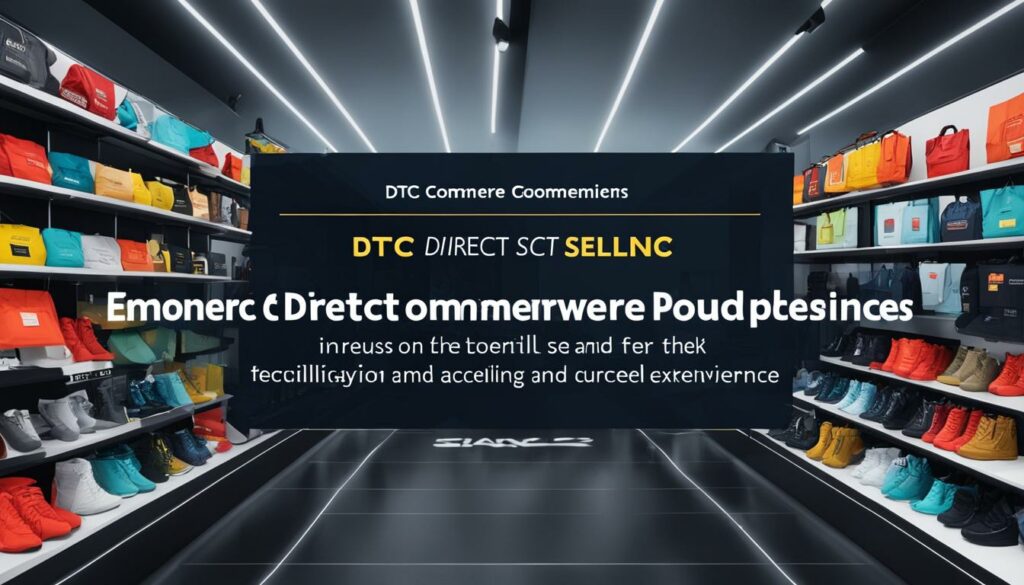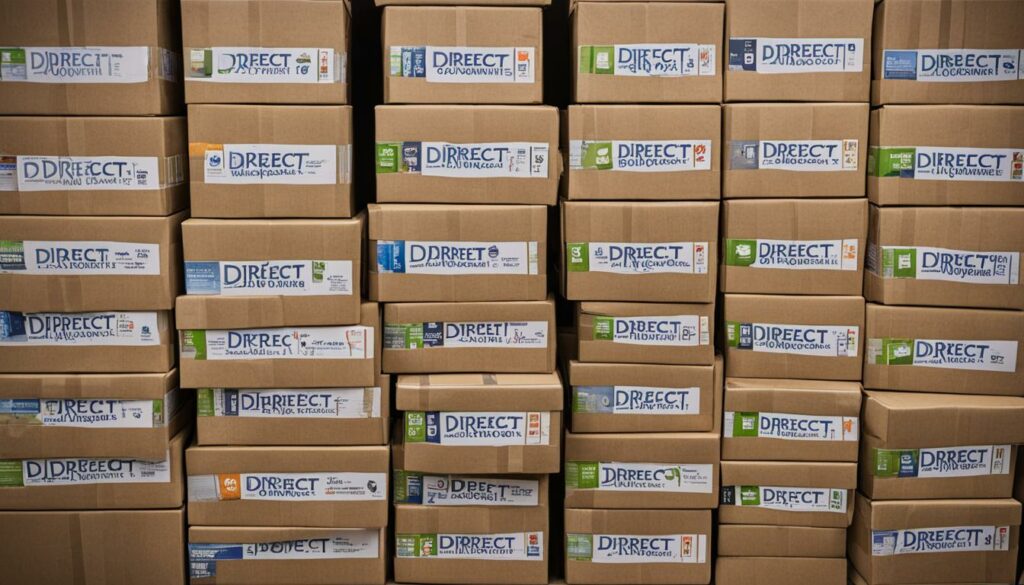In the world of ecommerce, direct-to-consumer (DTC) is a term that is rapidly gaining popularity. With established brands projected to reach $138.03 billion in DTC sales this year in the US alone, it’s evident that this retail model is on the rise. DTC in ecommerce refers to the practice of brands selling their own products directly to end customers, without the need for third-party retailers or wholesalers.
The appeal of DTC in ecommerce lies in the ability for brands to establish direct relationships with consumers and gain valuable insights. By cutting out the middlemen, brands have more control over product stock levels, sourcing, and the overall fulfillment experience. This control allows them to create personalized experiences for their customers, leading to higher profitability and a competitive edge in the market.
Some notable examples of successful DTC ecommerce brands include Burrow, Solo Stove, Method, Jennifer Taylor Home, and Bulk Nutrients. These brands have leveraged the DTC model to develop customer-centric capabilities and optimize their revenue and cost structures, paving the way for their success in the direct selling space.
While the shift to DTC in ecommerce presents its fair share of challenges, such as competition, logistics, customer service, and payment processing, the benefits far outweigh the obstacles. Brands that embrace the DTC model can forge stronger connections with their customers, streamline their operations, and achieve sustainable growth.
As the ecommerce landscape continues to evolve, DTC will undoubtedly play a pivotal role in shaping the future of retail. By understanding what DTC is and implementing effective strategies, brands can position themselves for long-term success in the ever-changing ecommerce landscape.
Key Takeaways:
- DTC in ecommerce refers to brands selling their products directly to end customers, bypassing third-party retailers or wholesalers.
- Brands that go DTC can establish direct relationships with consumers and gain valuable insights.
- DTC allows brands to have more control over product stock levels, sourcing, and the overall fulfillment experience.
- Personalized experiences, higher profitability, and a competitive edge are some of the advantages of the DTC model.
- Challenges such as competition, logistics, customer service, and payment processing need to be overcome for successful DTC implementation.
What is Direct to Consumer (DTC)?
Direct to consumer (DTC) in ecommerce refers to a retail model where brands or manufacturers sell their products directly to end customers, without the involvement of third-party retailers or wholesalers. In this model, DTC brands have complete control over their product stock levels, sourcing, packaging, and fulfillment.
They communicate with customers directly and have the opportunity to establish direct relationships and gain valuable insights. The DTC business model allows brands to bypass traditional retail channels and have more control over the customer experience. This can lead to higher profitability as brands eliminate costs associated with middlemen and can offer products at lower prices.
DTC brands often focus on personalized experiences, and they can offer a wider range of products without being limited by retailers’ preferences. DTC in ecommerce empowers brands by giving them more control over their sales and customer relationships.
“Direct to consumer (DTC) in ecommerce allows brands to bypass traditional retail channels and have more control over the customer experience.”
Direct to Consumer vs. Wholesale
Direct to consumer (DTC) and wholesale are two distinct sales models in ecommerce. In the wholesale model, producers sell their products in bulk to retailers, who then market and sell these products to consumers. This multi-tiered approach often results in higher costs for both producers and consumers. On the other hand, DTC eliminates the need for middlemen, allowing brands to sell their products directly to end customers, streamlining the supply chain and reducing costs.
By adopting a DTC strategy, brands can benefit from several advantages:
- Lower costs: Without the intermediaries involved in the wholesale model, brands can bypass markups and achieve higher profit margins. DTC allows brands to offer their products at lower prices, making them more competitive in the market.
- Enhanced profitability: By cutting out the middlemen, brands retain more control over pricing, promotions, and profit margins. This direct approach enables brands to optimize their revenue streams and increase profitability.
- Targeted marketing: DTC brands have direct access to customer data, enabling them to personalize marketing efforts and create targeted campaigns. This data-driven approach allows brands to reach the right audience with the right message, ultimately improving conversion rates and customer loyalty.
- Personalized experiences: Through direct communication with customers, DTC brands can create meaningful interactions and tailor the shopping experience. By understanding customer preferences and needs, brands can offer personalized recommendations, leading to increased customer satisfaction and loyalty.
“DTC brands can lower costs, enhance profits, and offer personalized experiences by selling products directly to end customers.”
The advantages of DTC in ecommerce go beyond financial benefits. By establishing direct relationships with customers, brands can gain valuable insights into their preferences, feedback, and behavior. This wealth of data enables brands to continuously improve their products, customer experience, and overall business strategy.
Let’s take a closer look at the comparison between DTC and wholesale sales models:
| DTC | Wholesale |
|---|---|
| Direct selling to end customers | Products sold in bulk to retailers |
| Bypasses middlemen | Involves multiple layers |
| Lower costs and higher profits | Higher costs for both producers and consumers |
| Targeted marketing and personalized experiences | Less control over customer experience |
| Direct access to customer data and preferences | Relies on retailers for customer insights |
| Increased control over sales and profitability | Limited control over pricing and promotions |
As the ecommerce landscape continues to evolve, more brands are recognizing the advantages of the DTC model. By going direct to consumer, brands can lower costs, enhance profits, and offer personalized experiences that drive customer loyalty. The shift towards DTC in ecommerce empowers brands with greater control over their sales, customer relationships, and overall business success.

Direct to Consumer vs. Retail
Direct to consumer (DTC) and retail are two different retail models in ecommerce. In the traditional retail model, brands or manufacturers sell their products to retailers, who then market and sell these products to end consumers. Retail involves multiple layers and can limit brands’ control over the customer experience and profitability.
On the other hand, DTC in ecommerce allows brands to sell their products directly to end customers, bypassing traditional retail channels. DTC brands have complete control over the product stock levels, fulfillment process, and customer communication. This retail model enables brands to establish direct relationships with customers, gain valuable insights, and offer personalized experiences.
By going DTC, brands can differentiate themselves from competitors, have more control over their sales, and potentially achieve higher profitability.
Benefits of Direct to Consumer
Direct to consumer (DTC) in ecommerce offers several advantages for brands. Embracing a DTC strategy can revolutionize a brand’s marketing, sales, and customer experience. Here are some key benefits of DTC in ecommerce:
- Increased Control: By selling directly to consumers, brands have complete control over their product inventory, pricing, and overall brand image. They no longer have to rely on third-party retailers or wholesalers, allowing them to make strategic decisions based on consumer demand and market trends.
- Direct Customer Relationships: DTC enables brands to establish direct and personalized relationships with their customers. By interacting directly with consumers, brands can understand their preferences, collect valuable data, and provide tailored experiences. This direct connection fosters loyalty and allows for targeted marketing campaigns.
- Profitability: Eliminating the middlemen in the retail supply chain can significantly increase profit margins for brands. DTC eliminates the costs associated with wholesalers and retailers, allowing brands to offer products at more competitive prices. This pricing advantage can attract more customers and drive higher sales volumes.
- Brand Differentiation: DTC in ecommerce provides brands with an opportunity to differentiate themselves from competitors. Brands can highlight their unique value propositions, tell their story, and build a strong brand identity that resonates with their target audience. This differentiation can lead to increased brand loyalty and customer retention.
Implementing a DTC marketing strategy requires careful planning and execution. Brands need to identify their target audience, optimize their online presence, and leverage digital marketing channels to reach and engage customers effectively. DTC in ecommerce has proven to be a successful strategy for many brands, allowing them to thrive in an increasingly competitive marketplace.
To illustrate the benefits of DTC, let’s consider an example:
“XYZ Shoes, a well-known footwear brand, decided to transition to a direct-to-consumer model in order to strengthen their brand positioning and increase profitability. By selling their products directly to consumers through their website and exclusive retail stores, XYZ Shoes was able to control their pricing, inventory, and customer experience. This direct approach allowed them to understand their customers’ preferences and offer personalized recommendations, ultimately leading to higher customer satisfaction and repeat purchases. In addition, XYZ Shoes could invest more in marketing and product innovation, thanks to the higher profit margins achieved through the DTC model. As a result, their online sales skyrocketed, and they established a loyal customer base that appreciated the brand’s commitment to quality and customer service.”
By leveraging the advantages of DTC in ecommerce, brands like XYZ Shoes can thrive in the competitive market and create lasting relationships with their customers.
| Advantages of DTC in Ecommerce | Description |
|---|---|
| Increased Control | Brands have complete control over product inventory, pricing, and brand image. |
| Direct Customer Relationships | Establish direct and personalized relationships with customers, gaining valuable insights and fostering loyalty. |
| Profitability | Eliminate costs associated with middlemen, offering products at competitive prices and increasing profit margins. |
| Brand Differentiation | Create a unique brand identity that sets the brand apart from competitors, attracting loyal customers. |

Pitfalls to Avoid When Going DTC
While direct to consumer (DTC) in ecommerce offers many benefits, brands should also be aware of the challenges and pitfalls that come with this approach. Considerations for going DTC include:
- Competition: The DTC space is increasingly crowded, and standing out from competitors can be a challenge. Brands need to develop unique selling propositions and effective marketing strategies to attract and retain customers.
- Logistics: Managing the logistics of DTC sales can be complex, especially when it comes to inventory management, order fulfillment, and shipping. Brands must ensure they have robust systems in place to handle these operations efficiently.
- Customer Service: Providing excellent customer service is crucial in the DTC model. Brands need to be responsive to customers’ inquiries, complaints, and feedback. Implementing effective customer service policies and processes is essential for maintaining customer satisfaction.
- Payment Processing: Setting up secure and streamlined payment processing systems is necessary for a smooth DTC operation. Brands must ensure they comply with payment industry standards and regulations to protect customer data and facilitate seamless transactions.
Despite these challenges, with careful planning and execution, brands can successfully navigate the DTC landscape and reap the rewards of establishing direct relationships with their customers.
FAQ
What is DTC in ecommerce?
DTC in ecommerce refers to the practice of brands or manufacturers selling their own products directly to end customers, bypassing third-party retailers or wholesalers. It allows brands to establish direct relationships with consumers and gain valuable insights.
What is Direct to Consumer (DTC)?
Direct to Consumer (DTC) in ecommerce is a retail model where brands or manufacturers sell their products directly to end customers, without the involvement of third-party retailers or wholesalers. By going DTC, brands have complete control over their product stock levels, sourcing, packaging, and fulfillment.
What is the difference between DTC and wholesale?
In the wholesale model, producers sell products in bulk to retailers, who then market and sell to consumers. DTC eliminates the middlemen, allowing brands to sell directly to customers. It lowers costs, enhances profits, and enables more targeted marketing and personalized experiences.
What is the difference between DTC and retail?
In the traditional retail model, brands sell products to retailers, who market and sell to end consumers. DTC allows brands to sell directly to end customers, bypassing retail channels. It gives brands more control over the customer experience, relationships, and profitability.
What are the benefits of DTC in ecommerce?
Some advantages of DTC include establishing direct relationships with customers, gaining valuable insights, offering personalized experiences, and potentially achieving higher profitability.
What are the pitfalls to avoid when going DTC?
Some considerations when going DTC include competition, logistics, customer service, and payment processing. Brands need to develop customer-centric capabilities, optimize the economics of DTC, and overcome these challenges.
